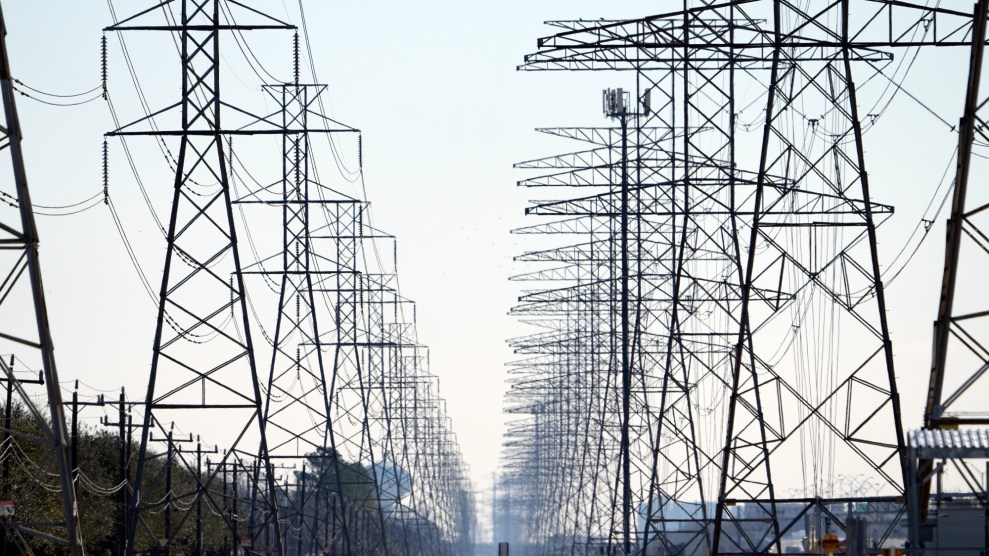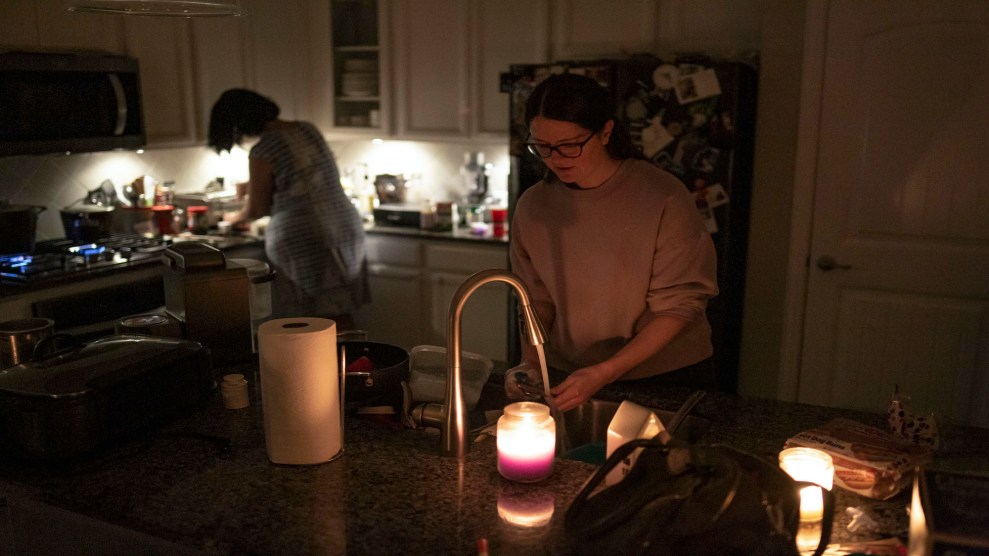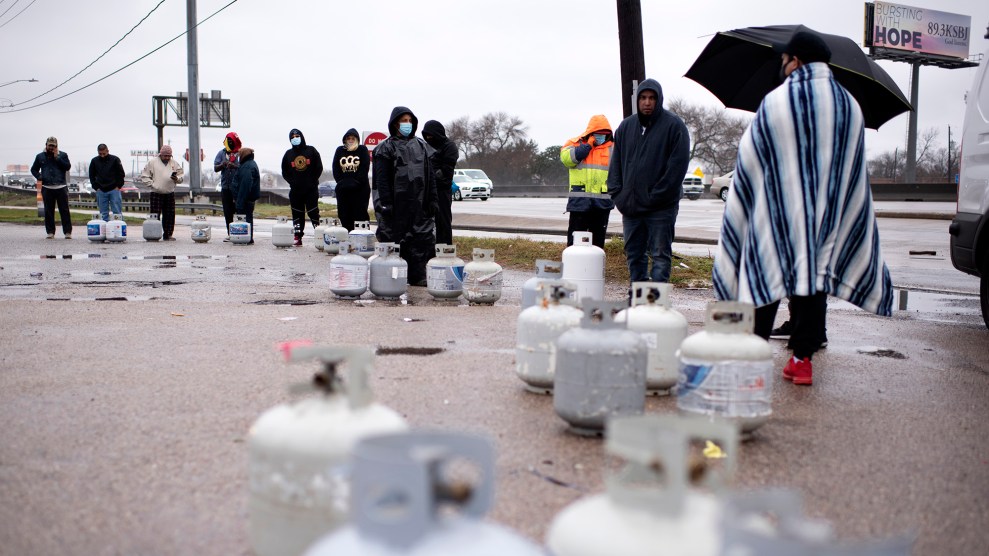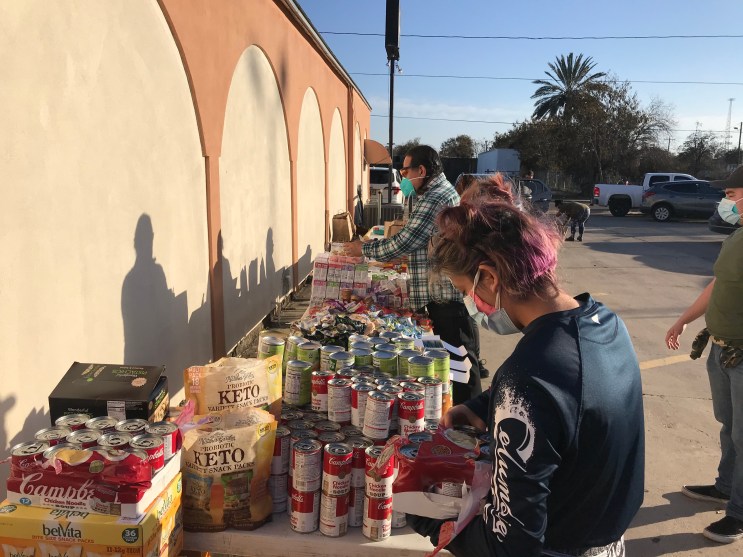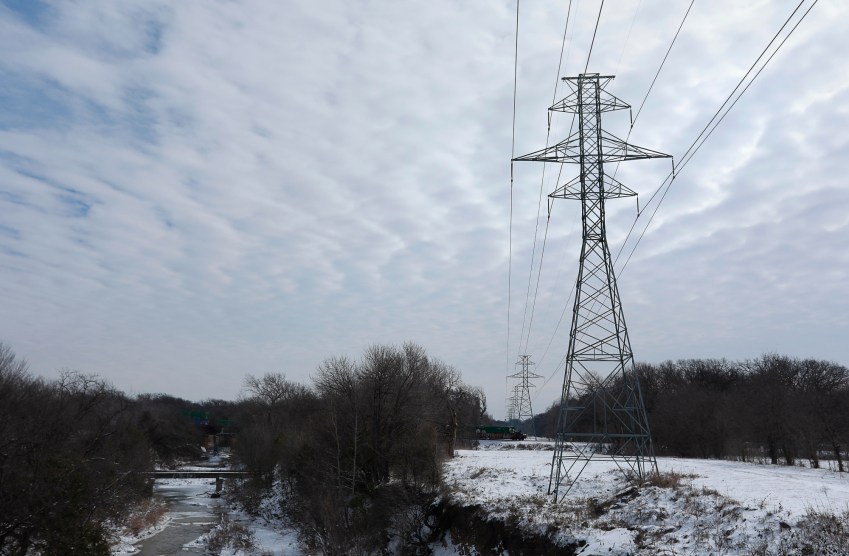
Ralph Lauer/ Zuma
This story was originally published by Wired and is reproduced here as part of the Climate Desk collaboration.
You could point fingers in several directions for the outages that stemmed from last week’s polar vortex obliteration of the Texas power grid. You can’t rightly blame Earth for doing what it does, but you could certainly condemn the state’s deregulation of its energy system. Texas also remains heavily reliant on fossil fuels, and the power plants that run on them failed en masse. So you might blame those operators, but you can’t blame renewables for this one.
But you’re not likely to see many people pointing fingers at the obscure yet fascinating eccentricities of the fragmented United States energy grid. And you’re even less likely to hear that what happened in Texas could help spur the country to better prepare its grid for the ascent of renewables—and our descent into the ravages of climate change.
In the future, the central challenge for the US will be obtaining power that is both clean and “firm,” in the parlance of energy nerds. “The real failing of Texas was the reliance upon the natural gas backbone as the firm power source, which of course wasn’t so firm, as they later learned,” says David Victor, a political scientist at the University of California, San Diego. He’s a coauthor on a National Academies of Sciences, Engineering, and Medicine report coincidentally released today called The Future of Electric Power in the United States. “If you want to decarbonize the grid, and keep power reliable, then you’ve got to have a clean, firm power source,” he continues. “That’s the central goal.”
But the US grid isn’t going to make the wide-scale sharing of clean energy easy—exporting solar energy from the Southwest, for instance, and wind energy from the Midwest. That’s because the mainland grid is divided into three sections. The Western Interconnection and the Eastern Interconnection meet at the eastern borders of Colorado and Wyoming, splitting the country in two. The Texas Interconnection is divorced from both in the name of energy independence, though it doesn’t trace neatly to the state’s borders—some of the panhandle is actually part of the Eastern Interconnection. And in the northern and southern parts of the US, our grids intertwine with those run by our neighbors. There’s a Quebec grid that exchanges power across the border with New England. The Pacific Northwest similarly exchanges with British Columbia, and Southern California with a little bit of Mexico’s Baja California Peninsula.
Each of these grids more or less does its own thing: Utility companies generate power and ferry it around their territories. These utilities are typically owned by a state, a municipality, or investors. The utilities regularly exchange power within an interconnection as energy demand waxes and wanes in a given area thanks to heat waves or cold snaps. So, for instance, in the West, high-voltage transmission towers carry electricity between Washington, Oregon, and California. But neither the eastern nor the western half of the national grid sticks tendrils into Texas in a way that would have let the state borrow large amounts of power when facing a massive, sudden freeze.
First of all, Texas would have had to fall back on a neighbor that was far enough away to not also be suffering an extreme cold snap. (Nearby states would be dealing with their own high energy demand and generation problems.) Even then, Texas could draw maybe 1 gigawatt of power from the Eastern Interconnection on a good day. For perspective, the state’s entire grid uses 60 gigawatts.
It’s not that the Western and Eastern Interconnections don’t exchange any power at all—they do it here and there at the local level. But they’re not thoroughly connected by those big high-voltage lines, which are the only way to carry electricity long distances. The Rocky Mountains quite effectively separate East and West. “It’s really evolved that way because in that part of the country, there just wasn’t much infrastructure,” says Jeff Dagle, chief electrical engineer at the Pacific Northwest National Laboratory. “And so nobody had an economic reason to build a bunch of high-voltage transmission lines to connect the grids together.”
And there’s another engineering challenge: The Western and Eastern Interconnections each hum at their own uniform frequency. If you had two meters and plugged one into a wall socket in San Francisco and the other in Seattle, you’d see the same readout. “Every motor, every generator, everything in that grid is running at the same speed in that entire grid,” says Dagle. “It’s kind of cool to think about.” But if you plugged a meter into a socket in New York City, it would be humming at the Eastern grid’s frequency. And, of course, you’d get a different reading in Dallas.
To get the Western, Eastern, and Texas Interconnections to talk to one another, they have to do so at the same speed. Electrical stations along their borders are indeed equipped to do this to exchange power across the interconnections, but “they’re very small and insignificant in the grand scheme of things,” says Dagle. “They’re really there for the economic value of the local utilities, being able to buy and sell power across that interface. But they’re kind of insignificant as it relates to the overall functioning of the grid.”
Texas also remains heavily reliant on fossil fuels, and its various methods of energy generation all failed to some degree when the polar vortex hit. The state gets 40 percent of its power from natural gas, but those facilities are outdoors, so their works froze up; they just weren’t prepared for such extreme cold. “You would not build a plant like that in Minnesota—you would put it indoors,” says Dagle. “So that’s fundamentally part of the problem.”
Texas’ coal and nuclear plants suffered frozen equipment too. Of all the state’s lost energy, 61 percent came from the failure of those two sources and natural gas. The other 39 percent of the loss came from wind and solar—solar panels snowing over and half of the state’s turbines freezing up. (The remaining still-spinning turbines played no small part in keeping the grid from total collapse. And it’s worth noting that proper weatherization allows wind turbines to keep spinning in freezing temperatures.)
This dearth of power coincided with extra-high demand for it. In the extreme cold, everyone needed to heat their homes, drawing electricity for powering space heaters or natural gas for central heat systems.
What could we do to create a grid that’s less prone to such disruptions? Build infrastructure to better link the interconnections. “They could build stronger ties between the Eastern Interconnection and the Western Interconnection and Texas to share power, and it actually would benefit them greatly,” says Ben Kroposki, director of the Power Systems Engineering Center at the National Renewable Energy Laboratory, who studies the national grid.
Take a look at the map above. That WI-EI Seam is the border between the Western and Eastern Interconnections. All the blue in the Midwest marks where wind is an abundant resource. The gold in the Southwest means abundant solar. The green bathing Texas is both. While the state is still highly dependent on fossil fuels for energy generation, it’s actually rich in renewable resources. If all the interconnections actually played nice with one another, Texas could be the place where they met in the middle, exporting solar and wind energy to its neighbors and importing their power when needed. You know, like during a polar vortex.
Notice the time stamps at the bottom of the map. The peak load in most places is between 4 pm and 9 pm, Kroposki says, as people return home and cook dinner and turn on heaters or AC units. If it’s 2 pm in Arizona, the sun is blazing on solar panels just as folks on the East Coast are ramping up their energy usage. “You could be pushing solar energy back east,” Kroposki says. Then as the Midwest moves out of peak usage, it could push wind energy back west.
Also, on the days the sun isn’t shining in the Southwest, those states could import wind power from Texas or the Midwest. If the wind refuses to blow in the Midwest, those states could import solar power from the Southwest or Texas. Ironically enough, Texas—the utility outlaw—could be a uniting force between all these regions.
But the country needs to build out high-voltage lines to more intimately intertwine the three regions. “These kinds of things would help integrate more renewables, because you could geographically distribute them,” Kroposki says. “You could put more renewables in the locations where the resources are really good, and move the power easier around the country.”
“The thing that holds all of this up is: Who’s going to pay for this infrastructure?” Kroposki adds. “It benefits everybody, but not in a way that’s easy to collect dollars from.” Realistically, the funding would come down from the feds. President Joe Biden has, after all, promised to build out green energy infrastructure to create 10 million jobs.
Prepare for mountains of red tape, though. We’re talking about miles upon miles of lines crossing through multiple states, each with their own regulatory hurdles. “I think we’re in a world where it’s going to continue to be difficult to site large, long-distance transmission lines, and we suggest greater authority for [the Federal Energy Regulatory Commission] to be able to do that,” says Victor, the coauthor on that National Academies report. “But we’re under no illusion that you’ll wave a magic wand to make that problem easy.”
While we’re waiting for that to happen, there may be another way to reinforce our grids with renewables on the local level: microgrids. Northern California’s Blue Lake Rancheria, for instance, has loaded up on solar panels and batteries so it can “island” itself from the main grid if necessary. Last fall—the peak of the state’s increasingly dire wildfire season—the local utility cut power to swaths of California to keep from sparking a blaze, and some 10,000 locals headed to the rancheria for fuel and supplies.
Without power, gas pumps don’t work and water treatment plants go offline, so you get an additional water crisis, as happened in Texas. But in this case, the rancheria served as a powered-up oasis. “The Blue Lake microgrid is a small drop in the bucket for the California grid, so it didn’t make a big difference,” says Peter Lehman, founding director of Humboldt State University’s Schatz Energy Research Center, which helped develop the microgrid. “But it’s a role model for how we can respond to those situations in the future.”
On a bigger scale, a city’s microgrid could incorporate fire and police stations, hospitals, water treatment plants, evacuation centers, and maybe even a grocery store or two. But these microgrids remain expensive. Battery prices are still high (though they’re falling), and each microgrid has to be purpose-designed for a given town. “It’s still costly to do this,” says Lehman. “But it’s a question of, how do we spend our money as a society? We’re essentially buying insurance. It’s an insurance policy against what just happened in Texas and what just happened in California.”
In the end, microgrids and a more integrated national grid could live in harmony. Microgrids would allow municipalities to become more energy-independent so they can keep the lights on following extreme temperatures and natural disasters, while a more robust network of high-voltage lines would make it easier to shuttle renewable energy around. “It could well be that the grid of the future is one that has a huge amount of decentralization, but still there’s a backbone of the central grid that provides vital services,” Victor says. “In that sense, you could have the grid of the past and the future simultaneously.”
